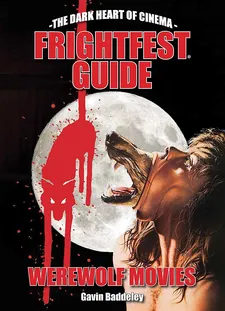 |
| The Frightfest Guide To Werewolf Movies |
What springs to mind when you think about classic movie monsters? For most people, werewolves will be in there somewhere. They’re astoundingly prolific – every decade has its famous werewolf films. Now former music journalist Gavin Baddeley has assembled The Frightfest Guide To Werewolf Movies, a compendium of reviews of some of the most important entries in the genre and a history of how they developed. In the run-up to this year’s Frightfest, we sat down to have a chat about the subject and how it all began for him.
“Lifelong lycanthropy obsessive is a bit of hyperbole but not that much. I’ve loved monsters since I was a kid and for some reason the Wolf Man and werewolves were always my favourite. Frankenstein, vampires, the mummy, they’re all great too, but for some reason werewolves are special. If I’m honest, I’m still not quite sure why.”
Were there particular films that got him into it as a kid?
He hesitates for a moment, then says “No. I mean I loved pretty much all of them... for me, the Hammer Gothic films are all part of the same thing, so there are some I like a bit more than the others but what I really like is this sort of enchanted world they create – and the same with the Golden Age Gothics from Universal. You know, if you put your serious film critic’s hat on then obviously some of them are better than others, but I like them all. In the book we’ve got around 200 films I review and a few more I talk about, and there are only a few films in there which I actively dislike.”
Would he say that it was the Universal films that really kicked off werewolf films in cinema or are there older ones that aren’t as well known?
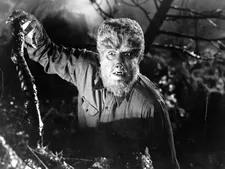 |
| Lon Chaney Jr as The Wolf Man |
“There are older movies,” he says, explaining that a lot of the earliest ones would today be classified as shorts. “Conventionally they say the oldest surviving werewolf film is a thing called Wold’s Blood, which is a batty, batty movie. It’s basically a melodrama where at one point in the proceedings the hero has been seriously bitten by the villain and his cronies and he needs a blood transfusion, and so he ends up in this cabin with the ‘renegade halfbreed moonshine bootlegger’ who refuses to give him a blood transfusion so the doctor has to use the bootlegger’s wolf. Then you get a sort of a werewolf thing going on but not really. And there are a couple of really early ones. About 1923 there’s the movie called The Werewolf and that hasn’t survived, and it’s more of a folkloric thing than a full blooded werewolf film.
“The oldest surviving werewolf film – nobody else seems to have picked up on this – is Nosferatu. Everyone forgets this – I forgot it – and of course there’s a scene with a werewolf in it. And that’s 1922. The first major werewolf film is a Universal thing called Werewolf Of London, which is 1935, but it wasn’t a big hit, so that version of the Wolf Man didn’t become part of the iconic Universal monsters. Then you have to wait until 1941 and you get the Lon Chaney Jr Wolf Man and for some reason that hits the spot.”
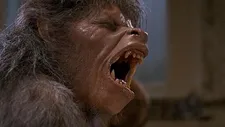 |
| The transformation scene in An American Werewolf In London |
Has the genre gone through a lot of changes over the years or does it still hinge on a classic formula that people continue to enjoy?
“Obviously, when you’re writing a book like this, you start having to define what you mean by a werewolf film,” he says. “It has to have a unifying factor otherwise it isn’t a thing. Beyond that, one of the fun things about writing a book like this is watching how outside events and changing fashions and all these things impact on a specific area like the werewolf film. There are movies which make a big impact and establish certain aspects of Hollywood werewolf myth. The Werewolf Of London was instrumental in introducing the importance of the moon and, I think, The Wolf Man [1941] was instrumental in making silver a big part of it, and then there are other things about the visual appearance of a werewolf.
“What does a werewolf look like? That’s not a conversation many people had had. If you think about The Wolf Man, Chaney doesn’t really look much like a wolf at all. He looks a bit more like a teddy bear. And then the big change you get is in An American Werewolf In London in 1981, which happens to come out at the same time as The Howling.” The transformation in the first of those, he says, has – in his opinion – yet to bettered, but he doesn’t find the werewolf itself as impressive as the more obvious hybrid creature that features in the second. “In order for this to work you have to create something that’s scarier than a wolf and scarier than a man.”
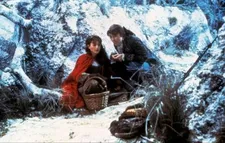 |
| The Company Of Wolves |
We discuss Curse Of The Werewolf and The Company Of Wolves, both of which came out around the same time. The latter, he notes, was underappreciated on release but went on to inform “a subgenre of fairy tale Gothic.”
I note that I found myself covering an awful lot of werewolf films about four years ago and a colleague says she’s been offered a lot recently. Are there more of them around now?
“I think there are a lot more being made because, in particular, of the way the technology has moved,” he says. “To make an indie movie 20 years ago required a lot more equipment, whereas now you can spend a few thousand quid and get some gear together to make something that you can potentially sell.”
I mention Wer and Late Phases, which he agrees were good, reflecting on how the former managed to turn the subject into a police procedural, and making a point of how impressed he was by Nick Damici’s performance in the latter.
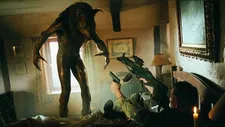 |
| Dog Soldiers |
“I liked The Snarling, a very recent Brit zero budget indie thing,” he adds... “I liked Howl. There’s quite a lot of good Brit indie films – I think Dog Soldiers can take credit for that... I’ve watched around 200 werewolf films in the past few months and I’ve enjoyed it but you do go a bit mad.” His schedule was tighter than originally planned, he explains, and there was a point when he was worried that he’d end up hating it – “and then there came a point where I sat down and I thought, you know, technically I am being paid to watch werewolf films. At which point you can crack open a beer and think ‘Things could be infinitely worse and this is actually quite cool.’
“When you talk to some people about this they start talking about which is their favourite of the Underworld movies, and yeah, it’s cool, but then you talk to someone else from a different cultural background or whatever you want to call it and you say ‘I’m watching the fifth Underworld movie,’ and they give you a look like you’ve just been handed a shit sandwich. But then you say to that person ‘Oh, I’m watching all 12 of the Paul Nasty Wolf Man movies,’ and they say ‘Oh, wow!’ You know? I think I’ve got better at appreciating both ends of that spectrum. One of the things I hope comes through in this book is how much I love horror movies.”
A lot of critic – even genre critics – seem to hate these films, he says sadly. “So I hope some of my love for this comes through.”
You can buy The Frightfest Guide To Werewolf Movies here.





















